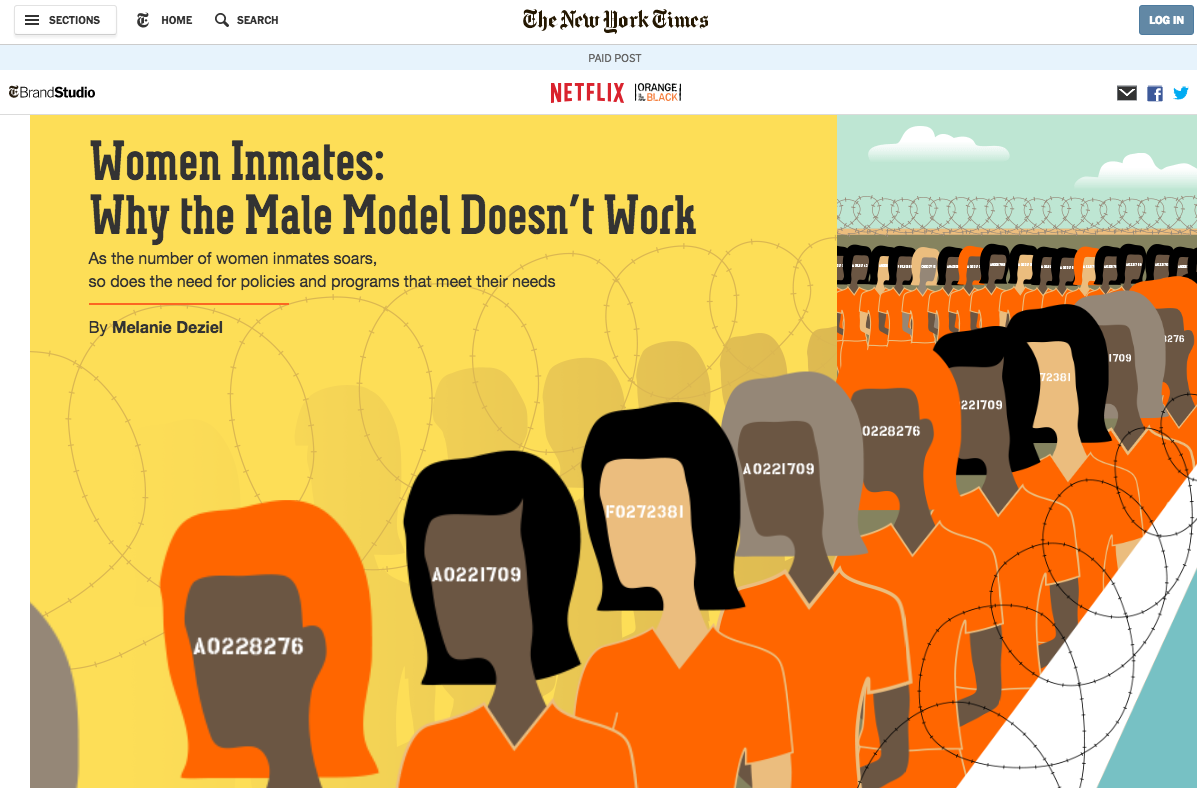We live in fast-changing times for branding, marketing and advertising. As more and more of us use recording devices that let you skip TV commercials, along with ad-blocking software online, how does a brand get its message across?
One increasingly popular strategy is to use branded content. From sponsored magazine articles to online webisodes, music videos to short films, this kind of content is so entertaining, informative and engaging that consumers are happy to view and share it of their own volition.
The marketing message may be upfront or almost invisible, but that's not what's important. It's all about making people want to see it, rather than being forced or tricked into seeing it.
Here we look at some of the best examples of branded content in the 2010s so far.
01. Newspaper article: Netflix

With the number of people willing to pay for newspapers and magazines falling, old media needs to find new sources of revenue – online as well as in print. One way to boost income is to run sponsored articles, but matching the right marketing message with engaging and informing content can be a tricky business.
This New York Times article, Women Inmates: Why the Male Model Doesn't Work, hits exactly the right note. Sponsored by Netflix's hit prison drama Orange is the New Black, the longform read is fascinating, relevant and elegantly presented. Interactive images, a captivating video and strong journalistic content all add up to a great article that ticks all the boxes for both brand and reader.
02. Music video: Honda
OK Go is an alternative rock band from Chicago known for its funny and creative music videos. And its video for 2014's I Won't Let You Down, which debuted on NBC's Today Show, put a whole new spin on product placement.
Get the Creative Bloq Newsletter
Daily design news, reviews, how-tos and more, as picked by the editors.
In it, the band members cavort around on Honda's UNI-CUB self-balancing unicycles, which represented a massive PR coup for the company. Although there's no actual mention of Honda, the video on YouTube – which has so far had over 38 million views – linked to an interactive website (now offline), allowing people to see behind-the-scenes footage, interviews, and information about the Honda UNI-CUB itself.
03. Print magazine: Net-a-Porter

As one door closes, another opens. And with traditional publishers reluctant to launch new magazines, companies are fast stepping in to fill the vacuum. One of the most critically and commercially successful to date has been fashion retailer Net-a-Porter's magazine, Porter.
By combining access to the website's audience data with global magazine market intelligence, the company has been able to target the magazine's content with laser accuracy, and achieve a circulation of around 180,000, outselling many traditional fashion magazines and even coming within spitting distance of Vogue.
As well as making money from the cover price, Net-a-Porter has put a lot of effort into making sure the bi-monthly title also drives retail sales. For example, readers are able to scan a print issue with the Net-a-Porter app, and immediately arrive at the relevant purchase page, making for a seamless shopping experience.
Porter's sister title The Edit is even more transparent about its brochure-like ambitions, with buttons in the free digital magazine taking readers to 'shop the issue'.
04. Viral video: Dove
Dove's Real Beauty campaign stems from research suggesting that only four per cent of women would describe themselves as beautiful. This short video highlights this gap between perception and reality in brilliant fashion.
A sketch artist creates two drawings of a series of women. One is based on their own description of how they look; the other based on a stranger's description. The discrepancy between the two highlights powerfully how inaccurate women's own views of their beauty are.
With over 114 million views in just one month, this ad became the most viral video ad of all time. While it says nothing about the qualities of the product itself, the campaign got the world talking, and Dove has been part of that conversation – boosting sales massively in the process.
05. Radio station: Pedigree
Content marketing isn't just about print, TV and online: broadcast radio remains a powerful and popular medium, and fertile ground for branded content. But perhaps the most unlikely example comes in the form of a New Zealand radio station for dogs.
K9FM was based on advice from pet experts that people should leave the radio on when they leave the house, to keep their dog company. But rather than a normal radio station, Colenso BBDO Auckland thought, why not one tailored to dogs themselves?
The agency created hours of original content to play all day, every day on the channel, including discussions on topics like The Frisbee: Voodoo, Magic, Science?; a sports section called Fetch in the Park, and a thought for the day entitled Chew on This.
K9FM received more than 1,000 phone calls from dog owners during the first two weeks of broadcasting, and within the three months of the campaign, Pedigree dog food enjoyed a three-year sales high.
06. Short film: Procter & Gamble
The maker of Always, Procter & Gamble, wanted to place puberty's profound impact on girls' confidence into the media spotlight. So it commissioned this short documentary by filmmaker Lauren Greenfield, which approaches the topic via the phrase 'like a girl'.
A series of interviews show that for young children, 'like a girl', means to do something well, whereas for teenagers and young women it means to do it ineffectively.
The fourth most viewed ad in 2014 on YouTube, the video was followed up by several positive #LikeAGirl videos featuring sporting and cultural role models offering proactive solutions. For example, a 2015 video featuring Game of Thrones star Maisie Williams, Unstoppable, encourages girls to smash limitations set on them by society, which are visually interpreted as boxes stamped with prescribed roles for girls.
07. Feature film: Lego
You know you've succeeded at branded content when people are having so much fun, they don't even notice they're being marketed to.
The hilarious and surprisingly clever Lego Movie earned a worldwide total of over $469 million, all the while promoting Lego to a new global generation of kids.
It has been followed up so far by the Lego Batman Movie and Lego Ninjago Movie, with more in the pipeline – proving that when you get branded content right, everything really is awesome.
Read more:

Thank you for reading 5 articles this month* Join now for unlimited access
Enjoy your first month for just £1 / $1 / €1
*Read 5 free articles per month without a subscription

Join now for unlimited access
Try first month for just £1 / $1 / €1

Tom May is an award-winning journalist and editor specialising in design, photography and technology. Author of the Amazon #1 bestseller Great TED Talks: Creativity, published by Pavilion Books, Tom was previously editor of Professional Photography magazine, associate editor at Creative Bloq, and deputy editor at net magazine. Today, he is a regular contributor to Creative Bloq and its sister sites Digital Camera World, T3.com and Tech Radar. He also writes for Creative Boom and works on content marketing projects.
